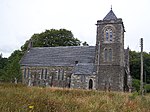Bishop's Glen Reservoir
Glens of CowalHighlands and Islands of ScotlandLandforms of DunoonReservoirs in Argyll and ButeScotland stubs ... and 1 more
Use British English from December 2016

Bishop's Glen Reservoir also known as Dunoon Reservoir used to be the source for drinking water for the town of Dunoon on the Cowal peninsula, Argyll and Bute, Scotland, a function now satisfied via Loch Eck. Records show that this impounding reservoir was created before 1880. The Balgaidh Burn is the main inflow and outflow. The angling of the Bishops Glen Reservoir is managed by the Dunoon and District Angling Club.
Excerpt from the Wikipedia article Bishop's Glen Reservoir (License: CC BY-SA 3.0, Authors, Images).Bishop's Glen Reservoir
Nelson Street,
Geographical coordinates (GPS) Address Nearby Places Show on map
Geographical coordinates (GPS)
| Latitude | Longitude |
|---|---|
| N 55.948 ° | E -4.9487 ° |
Address
Nelson Street
PA23 7EL , Auchamore
Scotland, United Kingdom
Open on Google Maps









